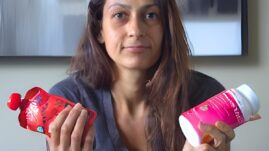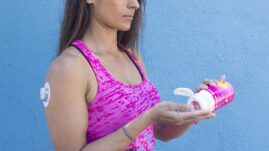If you regularly do cardio (like running, swimming, dancing, etc.), you have probably noticed that your blood sugar reacts differently depending on the type of cardio.
While steady-state cardio will usually make your blood sugar drop, interval training can make it increase.
The same goes for resistance training (weight lifting) and blood sugar. Some types of resistance training will make your blood sugars increase!
In this post, I’ll talk about how different types of resistance training affect your blood sugar and the strategies you can try to proactively manage your blood sugar during and after resistance training.
Always discuss changes to your insulin doses with your medical team. Since we’re all a little different, you may need to adjust differently for exercise than I do.

Table of Contents
- Why resistance training is good for people with diabetes
- How high-rep resistance workouts affect my blood sugar
- How low-rep resistance workouts affect my blood sugar
- How to prepare for resistance training and prevent post-workout lows
- How to adjust your insulin up to 36 hours after a resistance workout
- Summary
Why resistance training is good for people with diabetes
I absolutely love resistance training for three reasons:
- Resistance training makes me feel strong and empowered.
- Resistance training has helped me shape my body to my liking.
- Resistance training ultimately makes my diabetes easier to manage, as it improves my body’s ability to utilize insulin.
Resistance training generally falls into two categories
- Low-rep (heavy) training with pauses between each set.
- High-rep training or supersets with little rest between sets. Your heart rate is elevated throughout the workout.
Each type of resistance training will affect my blood sugar a little differently during my workouts but they both have the same long-term benefit of a significantly improved insulin sensitivity.
How high-rep resistance workouts affect my blood sugar
In general, I need to be a little more careful and watch my sugars more closely if I do high-rep workouts, supersets, or a lot of compound leg exercises (like squats, deadlifts, or lunges).
These kinds of workouts will have a cardio-like (aerobic) impact on my blood sugar since my heart rate will be elevated for most of the session and I can expect my blood sugar to drop.
I treat sessions like these almost as I would treat steady-state cardio – by reducing my pre-workout insulin dose by about 30%-50%.
How low-rep resistance workouts affect my blood sugar
When it comes to more traditional resistance training with fewer reps (less than about 12 reps per set), the situation is a little different. When doing workouts like this, I sometimes see my blood sugar go up, and sometimes I don’t see much of an impact at all. It comes down to what body part I’m training.
For smaller muscle groups like arms and shoulders, my heart rate won’t usually increase that much despite the heavy weights, and my blood sugar will remain stable. If I do heavy chest, back, or leg workouts, however, I’ll most likely see an impact on my blood sugar, and it can often be an increase. My body reacts in the same way as when I do an interval cardio workout.
Given this knowledge, I’ll reduce my pre-workout insulin dose minimally or not at all for a low-rep workout, depending on the body parts I am training.

How to prepare for resistance training and prevent post-workout lows
When it comes to resistance training, pre-workout meals play a huge role in whether you’ll be successful in the gym. I always eat something before and after a strength-training workout to ensure I have enough energy to do the workout, rebuild my muscles, and maintain good blood sugar levels.
My pre-workout snack is a fairly low glycemic carb (like brown rice) and some lean protein (like chicken breast) which I eat about an hour before my workout. By eating a low glycemic carb and some protein, I get enough energy for my workout without having to take a lot of insulin.
My post-workout snack consists of a low or high-glycemic carb with an easily digested protein (like fruit and a whey protein shake).
As mentioned, I generally reduce my insulin dose for the pre- and post-workout meals by up to 50%, especially on high-rep and superset days, due to the cardiovascular (aerobic) component of the workout, which always makes my blood sugar drop.
However, taking a bit of insulin before a resistance training workout also has the benefit that it reduces my risk of high blood sugar during the low-rep sessions.
How to adjust your insulin up to 36 hours after a resistance workout
My approach to insulin adjustments for the 24 to 36 hours after I leave the gym is the same no matter what kind of resistance training I’ve done.
What happens when you do resistance training is that you create microscopic tears in your muscle fibers, and for the next 24 to 36 hours, your muscles heal and get bigger and stronger. During this period, your muscles need energy to heal and that has to come from somewhere, so low blood sugars can easily be the result if I don’t plan ahead.
If I do resistance training less than four times per week, I will typically have to reduce my nighttime basal insulin by up to 50% on the days on which I work out (this is different for every individual so you need to experiment and track your results to find what works best for you).
If I do resistance training more than four times per week, the increased insulin sensitivity is present all the time and I can simply lower my nighttime basal permanently without having to adjust for individual workouts.
Note: If you do resistance work to the point of severe or delayed soreness, you can actually increase insulin resistance. If the muscles are being repaired for several days due to extreme damage, you can’t restore glycogen in them until the repair is done, and that causes insulin resistance.
Summary
I find it easier to adjust for resistance training than for cardio, as long as I am very aware of the kind of resistance training I am doing and remember these guidelines:
- High-rep workouts in which your heart rate is elevated will most likely make your blood sugar drop.
- Low-rep workouts that don’t elevate your heart rate significantly (like arms or shoulders) most likely won’t affect your blood sugar.
- Hard low-rep workouts of large muscle groups can affect your blood sugar like an interval workout, potentially leading to an increase in blood sugar.
- Don’t be scared of eating!!! Eat enough lean protein and carbs to fuel your workout, ensure muscle recovery, and (with the appropriate insulin dose) stabilize your blood sugar levels.
- Consider reducing your insulin levels appropriately during the 24 to 36 hours after a workout to adjust for the type of resistance training you’ve done.
Have fun in the gym!





MTH
How do you adjust insulin post strength training if you’re not on a pump? I use multiple daily injections with a basal insulin (Tresiba) and rapid acting insulin (Fiasp). Both my heart rate and my BG shot up precipitously during weight/strength training.
I’ve ben able to reduce my lows during cardio (5X week) making adjustments using your exercise/food/insulin log. Overall I’ve reduced my Tresiba by 2 units since regular exercise, so that’s good. Not sure how to adjust for strength training (2X week), though.
Christel Oerum, MS
With a Fiasp/Tresiba combination your main option will be to reduce your Fiasp post training and potentially increase it before to prevent high blood sugars during resistance training workouts. I prefer a not as ultra long basal insulin as they are easier to adjust than an insulin like Tresiba that has a duration of up to 42 hours
Penny
I know this is an older post, but thank you. My blood sugar always goes up after doing Kettlebells and drops dramatically after a spin class. I didn’t realize that others have the same thing. Good to know.
Gerby
I am just the opposite. I am almost 65 yrs old, male and have been strength training and doing cardio for 50 years, year round. I am not diabetic, but insulin resistant. This morning was a typical example of my blood sugar reactions. My fasting BG this morning was 100, I admit I ate nearly a whole box of Little Debbie Swiss Rolls for breakfast (nice diet huh), my BG went up to 156, then after about 10 minutes of my curl workout (with a 61 pound curl bar…20X, rest, 15X, rest, 10X, rest, 10X, rest, then 20X with 41 pounds), my BG dropped to 104. This is typical for me. It will probably go up some later though. Cardio does not lower my BG much if at all.
Stella Pampoulides
I was trying to understand how to adjust my insulin, I do a leg work out every 3 days and an incline walk on the treadmill in-between, but I’m noticing my blood sugar is high I think, how would you adjust this?
Christel Oerum
The first thing I’d think about is; even though your blood sugars go high during the workout, do they come down by themselves after, or do you need to correct them?
If they come down by themselves you might just need to adjust your insulin timing so it peaks when you usually go high (remember rapid-acting insulin peaks in 60-90 min after injected). If you find that you need to correct, then you could consider giving that insulin earlier, so that you don’t spike at all. I would recommend using my tracking sheet (which can be found in this article: https://diabetesstrong.com/find-formula-insulin-food-around-workouts/) for a while to see trends so that you can implement the appropriate strategy for you
Herb
I’ve read this post a few times. I’m a type 2 diabetic and things are somewhat different for me because I don’t use fast acting insulin. I was a contest bodybuilder in the 70, and I’m 67yrs old now. I developed diabetes 18yrs ago and I started to train again 2yrs ago. No matter what I do my level elevates after training. I use Lantus and Victoza along with Metformin. I always train fasted and the sugar usually goes up around 30 points. Any thoughts on how I can keep it down?
Christel Oerum
You can try and use some light cardio to help your blood sugars come down. You might also see less of a blood sugar impact if you eat something before you workout. It could be something small, such as a few slices of chicken.
Another thing to consider is how long your blood sugars stay elevated and if it also happens on non-exercise days. If it does then your doctor might need to adjust your meds
Prem
I went for glucose tolerance test Sunday morning and before that on Saturday evening I did some heavy weight training so that I could clear my ggt but I failed the test with reading of 170 after 2 hours . After 4 days gain I went for glucose tolerance test in the morning and this time I didn’t do any weight training exercises evening before and my sugar reading were 130 after 2 hours. Can you give me the reason why this happened.?
Christel Oerum
That’s only 2 data points, so hard to say anything conclusive. Given the test was at two different times a day, that could be a variable, what you ate during the day could also very well be a significant variable. Usually, blood sugars should come down relatively quickly after resistance training, assuming you have enough insulin circulating in your body. If you have diabetes, and not enough insulin circulating, your blood sugars will not come down as fast. I would ask for an A1C test instead
Guy
Hey Christel, great article!
On your high-rep workouts, what kind of workout volume are we talking about? (e.g.: sets per bodypart, total sets, etc)
Christel Oerum
Thank you. When I say high rep, it’s usually anything higher than 12, and often up to 25-30. Volume will really depend on your goals and how much time you have to exercise. Could be 3x full body or a 5-day body part split
Ashley
Hi Christel 🙂
I’ve been doing strength training in the gym for the past few months to get lean/toned; currently I’m wearing the Dexcom G6 (on upper arms) and my Omnipod pump (abdomen/upper thighs). My one major concern is the efficacy of the two devices once I start losing more body fat and gaining more muscle in those areas – I don’t have much grab-able fat to begin with lol! Have you noticed anything wonky with CGM readings or insulin efficacy in more muscly areas (and pain when inserting)?
Christel Oerum
Oh, fun! I don’t wear a pump so I can’t give any personal feedback on that. But I’ve seen people wear their pods on their upper backs so guessing little fat tissue isn’t a big issue. If it is, an alternative is to put it on your breasts (Sounds a little iffy, but I know women who love that placement).
I didn’t wear a pump back when my body fat was competition level low, but have when relatively lean, and haven’t had an issue with it. I’m one of those women who always can find a place to pinch 🙂
Mike
I’m new to insulin long acting, but I’m an old school weight lifter. 5 days a week. I have noticed a spike in my sugar after a long grueling leg workout. So I should back off on my insulin amount the evening before and the evening after my heavy workout sessions? I’m going to recheck my levels about 2 hours after my lifting to see where my level is. I checked it before and it was 130, I check my sugar right after my leg workout and it was 221.
Christel Oerum
If you see an increase in blood sugars I wouldn’t back off on insulin. The way I manage for heavy lifting days is to ensure I have enough rapid-acting insulin on board (IOB) to not see an aggressive increase after my workout. If I’ll start to go low overnight, I’ll reduce my basal. However, we’re all different so you’ll need to experiment (collaborate with your medical team if needed) to figure out the exact adjustment for you
Kushal
Hello ma’am recently I’ve been detected with type 2 diabetes
I’m doing my workouts at home because of lockdown
Can you please tell me whether i can take whey protein in between the sets of resistance training
Christel Oerum
Your protein intake timing is less important than getting enough protein throughout the day. I like to get some protein in before my workouts but if having food in your system bothers you, you can just as easily wait